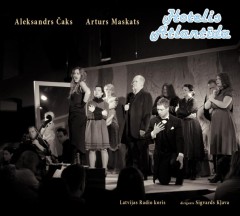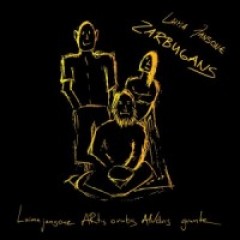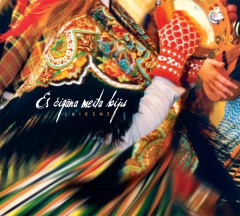
The poetry of Latvian poet Aleksandrs Čaks, with its vivid descriptions of the city of Riga – both the bright and not so bright characteristics, featuring characters such as prostitutes, drunkards, even cockroaches, might translate well to a theatrical setting, one might think.
In fact, this idea became reality a few decades ago, when Latvian composer Artūrs Maskats wrote melodies for a number of Čaks’ poems, performed at the time by Ivars Kalniņš. The years went by, and the idea to bring these songs back to public life blossomed and Maskats began work on more songs with lyrics by Čaks.
These new songs, along with new arrangements of the older songs, became the project Hotelis Atlantīda, a musical/theatrical event that featured the Latvian Radio Choir (musical director Sigvards Kļava) and was premiered in April of 2012, and was directed by Viesturs Kairišs (who also was the author of the libretto).
A CD of the same name has been released, and now listeners can now be brought back in time to the Riga of the past, with not just its many seedy elements, but also with many charming and quaint aspects that may have been lost over the years.
Besides the texts by Čaks, much of the atmosphere is provided by the band, including Aldis Liepiņš playing the piano, Indulis Cintiņš on violin, Jānis Stafeckis on contrabass, Ivo Krūskops on percussion, as well as both Kārlis Bimbers and Iveta Romancāne playing the accordion. The instruments are essential to the action and atmosphere on Hotelis Atlantīda, and deserve much of the credit for the success of the work – for example, the sorrowful violin in “Klaidonis”, complementing the bitter words of the titular wanderer, gloomy laments like “Rūgtas dziesmās es izkliedzu sirdi” (In bitter songs I scream out my heart).
Though Maskats provides the melodies, many of the actual arrangements were done by other composers, and many of Latvia’s brightest composers were involved in this process – including composers such as Andris Sējāns, Anitra Tumšēvica, Emīls Zilberts, and Jēkabs Nīmanis.
The distinctive baritone of Ivars Cinkuss is one of the many stars in Hotelis Atlantīda, appearing on six of the numbers, providing what one might call the ‘soul’ of the performance, with the rueful prayer ‘Lūgšana’, or the plaintive ‘Vai varu tev pie kājām likt’, as well as the bitterly sentimental ode to the city outskirts in ‘Nomalei’, bringing the necessary haunted disenchantment that many of Čaks’ characters exhibit.
Singers Kristīne Barkovska and Agate Burkina give life to the world weary, cynical Rīga prostitutes depicted in the song “Prostitūtas dziesma”, singing about their various types of clients, and “tikai plaukstošs veikals labs” (only a blossoming store is good).
Perhaps one of Maskats’ most famous works is his setting to music of Čaks’ poem, the ode to Riga ‘Rīgai’. Celebrating both the ‘old’ Riga (“Rīga, sirmā Rīga”) and the ‘new’ Riga (“Jaunā, skaistā RĪga”), this song, though originally written as a song for a solo singer, has since become a popular choir work, and a perennial favorite at song festivals based around the anniversary of Riga. The Radio Choir provides both the necessary tenderness and reverence for this moving tribute to the Latvian capital city.
Composer Maskats, who has been working with theater music for much of his career, is clearly an ideal choice for adapting the works of Čaks to music. As much of his music has a dramatic, and yet romantic, aspect to it, the music of Maskats brings these characters of Čaks to a vibrant life – the music provides additional personality aspects, making them living and breathing beings that are also given form by the singers of the Latvian Radio Choir.
The combination of Aleksandrs Čaks’ poetry, Artūrs Maskats’ music, the Latvian Radio Choir’s singing and dramatic talent (under the direction of Sigvards Kļava) is a potent combination not to be missed. Čaks’ characters and images are vividly portrayed in their full colorful, if a bit scruffy, glory. Hotelis Atlantīda at once not only displays the talents of the singers of the Latvian Radio Choir, but also of composer Maskats, and, of course, the unique ability of Aleksandrs Čaks to breathe into existence the denizens of Riga, no matter what walk of life they are from.
The Latvian Radio Choir web page: http://www.radiokoris.lv
The Latvian Radio Choir on Facebook: https://www.facebook.com/pages/Latvian-Radio-Choir/122477347765305
Details
Hotelis Atlantīda
Latvian Radio Choir
Latvijas Koncerti, 2013
LK-019
Track listing:
1. Vai varu tev pie kājām likt
2. Lūgšana
3. Spēlē, spēlmani
4. Viesmīļa dziesma
5. Matrozis laķenēs
6. Noktirne
7. Šansons III
8. Pašpuikas dziesma 2
9. Nomalei
10. Nomaldījies
11. Šansons I
12. Klaidonis
13. Prostitūtas dziesma
14. Pašpuikas dziesma
15. Šansons II
16. Meitene sērās
17. Romance
18. Puteklis
19. Divi vientuļi
20. Rīgai
21. Sirds
22. Rīga





